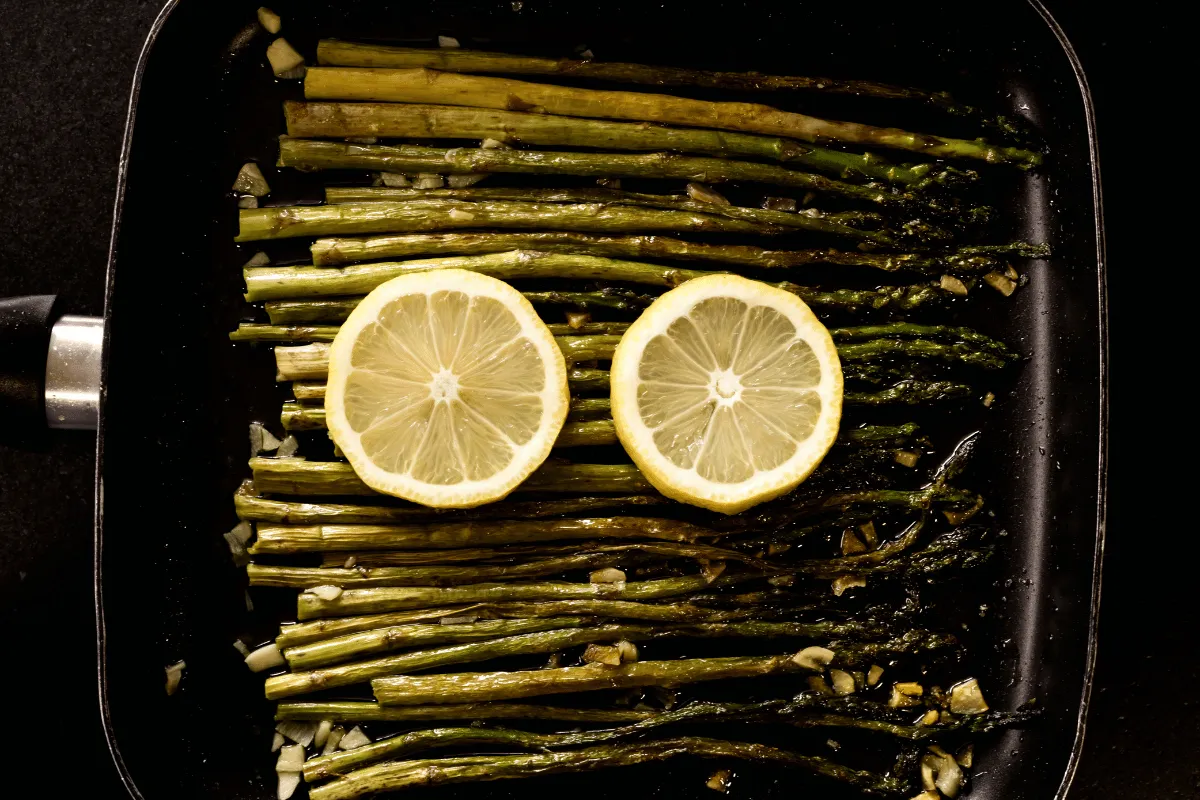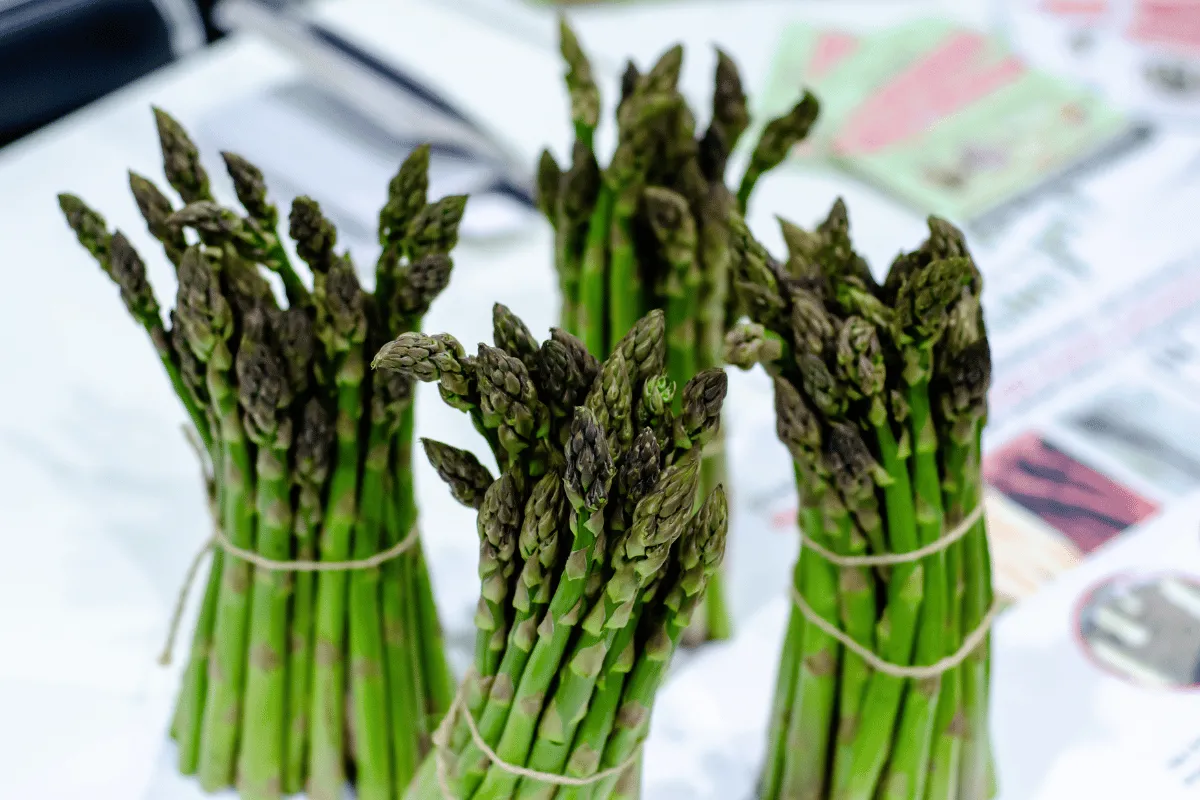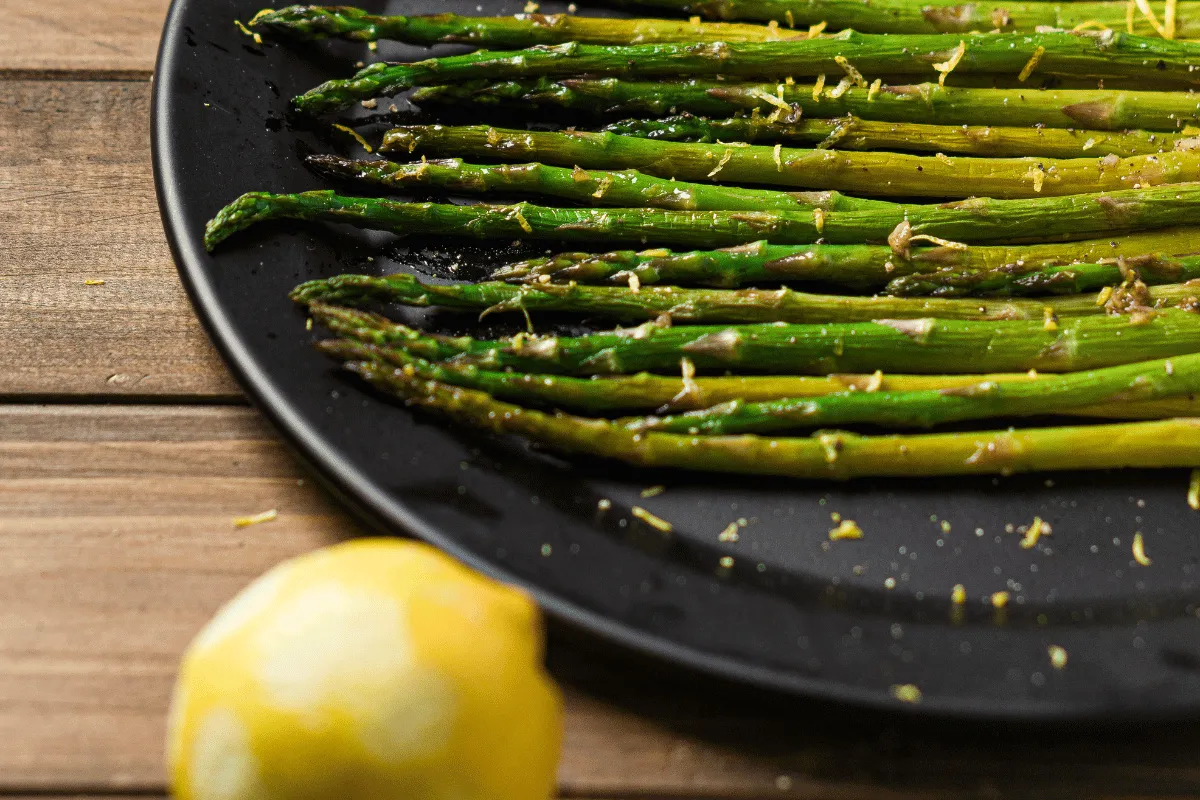Selecting and Preparing Asparagus
Choosing the Best Asparagus
Picking the perfect bunch of asparagus is the first step toward a delicious meal. Look for stalks that are bright green, with tightly closed tips. The spears should be firm and straight, with no signs of wilting or dryness. Remember, the thickness of the spear doesn’t necessarily indicate quality; both thin and thick asparagus can be equally tasty, depending on how you plan to use them.
Once you’ve brought your bounty home, proper storage is key to keeping asparagus fresh. Trim the ends and store the spears upright in a glass of water, loosely covered with a plastic bag, in the refrigerator. This little trick can keep your asparagus crisp and fresh for several days.
Preparation Techniques
Before you start cooking, giving your asparagus a good rinse under cold water will remove any grit. Snap off the tough, woody ends at the bottom of the spears – they’ll naturally break where the tenderness begins. If you’re feeling fancy, you can also peel the lower ends of the stalks with a vegetable peeler for an extra-smooth texture.
Now, onto the fun part – cooking asparagus! This versatile vegetable can be prepared in a myriad of ways, each bringing out its unique flavor and texture. Here’s a quick overview:
- Blanching: Quick and easy, blanching asparagus in boiling water for a few minutes until bright green and tender-crisp is a foolproof method. Immediately plunge the spears into ice water to stop the cooking process and preserve their vibrant color.
- Roasting: Roasting asparagus in the oven with a drizzle of olive oil and a sprinkle of salt enhances its natural sweetness. It’s a hands-off method that yields delicious results.
- Grilling: For a smoky flavor, grilling asparagus is the way to go. Just toss the spears with a bit of oil and seasonings, then grill over medium heat until charred and tender.
Each method brings out a different side of asparagus, from the crisp freshness of blanched spears to the caramelized richness of roasted ones. Experiment with these techniques to discover your favorite way to enjoy asparagus.

With your asparagus selected and prepared, you’re well on your way to creating mouthwatering dishes that showcase this springtime favorite. Up next, we’ll dive into an array of asparagus recipes, from time-honored classics to innovative new twists that will inspire you to see asparagus in a whole new light. Stay tuned!
Asparagus Recipe Variations
Simple and Classic Asparagus Recipes
Let’s kick things off with some simple and classic asparagus recipes that have stood the test of time. These dishes highlight the natural flavor of asparagus, making them a hit at any table.
- Steamed Asparagus with Hollandaise Sauce: Steaming asparagus preserves its bright green color and tender texture. Drizzle it with a rich, lemony hollandaise sauce for a touch of elegance. This dish is a testament to the adage, “less is more,” showcasing asparagus in all its glory.
- Roasted Asparagus with Garlic and Lemon: Roasting asparagus intensifies its flavor, and when tossed with minced garlic and a squeeze of fresh lemon juice, it transforms into a vibrant side dish. The garlic adds a warm depth, while the lemon brings a zesty brightness, creating a harmonious blend of flavors.
Creative Asparagus Dishes
Now, for those who love to experiment in the kitchen, these creative asparagus dishes offer a twist on the traditional, incorporating bold flavors and innovative pairings.
- Asparagus and Parmesan Tart: Imagine a flaky pastry crust filled with a creamy mixture of eggs, crème fraîche, and Parmesan, topped with tender spears of asparagus. This tart is not only visually stunning but also a delight to the taste buds, perfect for brunch or a light dinner.
- Asparagus Risotto with Gorgonzola and Hazelnuts: This risotto brings a luxurious creaminess to the table, with the bold flavor of Gorgonzola and the crunch of toasted hazelnuts adding layers of texture and taste. It’s a dish that’s sure to impress, offering a sophisticated twist on the classic risotto.
- Grilled Asparagus and Creamy Quinoa: Pairing grilled asparagus with creamy quinoa creates a dish that’s both nutritious and satisfying. The smoky flavor of the asparagus complements the nuttiness of the quinoa beautifully, making for a wholesome meal that doesn’t skimp on flavor.
Asparagus in International Cuisine
Asparagus takes center stage in dishes around the world, showcasing its versatility across various culinary traditions.
- Korean Spring Onion-Tied Prawn and Asparagus: This dish is a feast for the eyes and the palate, with prawns and asparagus bundles tied with spring onions. Served with a spicy dipping sauce, it’s a playful and flavorful way to enjoy asparagus with a Korean twist.
- Japanese Asparagus Shiraae: Combining asparagus with a tofu-based dressing, this Japanese dish is light yet satisfying. The creamy dressing, seasoned with sesame and miso, complements the crisp asparagus, offering a unique take on the vegetable.
- Hungarian-Style Asparagus: Baked with a topping of sour cream (or yogurt), paprika, and breadcrumbs, this dish highlights asparagus in a rich and comforting way. It’s a testament to how asparagus can shine in hearty, warming dishes.
With these recipes, from the simple to the sophisticated, asparagus proves to be a versatile star in the kitchen. Whether you’re sticking to the classics or venturing into new culinary territories, there’s an asparagus dish to suit every taste and occasion. Next, we’ll explore advanced cooking techniques and tips to elevate your asparagus dishes even further. Stay tuned for more green
Advanced Cooking Techniques and Tips
Elevating your asparagus dishes from good to great involves a sprinkle of creativity, a dash of technique, and the willingness to experiment. Let’s dive into some advanced cooking techniques and tips that will help you bring out the best in your asparagus recipes.
Elevating Your Asparagus Dishes
- Pairing Asparagus with Complementary Flavors: Asparagus loves company, especially when it’s the right kind. Pair it with ingredients that enhance its natural flavor. Lemon, Parmesan, garlic, and almonds are just a few companions that make asparagus shine. For a truly divine experience, try incorporating creamy sauces or tangy vinaigrettes that contrast beautifully with asparagus’s earthy notes.
- Tips for Achieving Perfect Texture: The secret to perfectly cooked asparagus lies in the balance between crunch and tenderness. Avoid overcooking by keeping a close eye on your asparagus, regardless of the cooking method. Remember, asparagus continues to cook even after it’s removed from the heat, so a quick plunge into ice water (blanching) can help stop the cooking process and preserve its vibrant color and crisp texture.
Troubleshooting Common Issues
- Avoiding Overcooked, Soggy Asparagus: There’s nothing sadder than mushy asparagus. To avoid this culinary tragedy, cook asparagus just until it’s al dente. Whether you’re steaming, boiling, or roasting, start checking for doneness a few minutes earlier than you think you should. Asparagus should be tender but still offer a bit of resistance when bitten into.
- Enhancing Flavor in Simple Dishes: If you’re aiming for simplicity but still want your asparagus dish to pack a punch, focus on seasoning and small additions that can elevate the overall flavor. A sprinkle of sea salt, a drizzle of high-quality olive oil, or a squeeze of fresh lemon juice can transform a simple dish into a standout.
By mastering these techniques and keeping these tips in mind, you’ll be well-equipped to tackle any asparagus recipe, turning everyday meals into memorable culinary creations. As we continue to explore the wonders of asparagus, remember that cooking is an art and a science, with each dish offering an opportunity to learn and grow.
Next up, we’ll address some frequently asked questions about asparagus recipes, providing you with expert answers and insights to enhance your cooking journey. Stay tuned for a deeper dive into the world of asparagus, where every spear is a story waiting to be told.

FAQs About Asparagus Recipes
Asparagus, with its vibrant color and distinct flavor, often raises questions among both seasoned cooks and culinary novices. Here, we’ll tackle some of the most common queries, providing expert answers to help you perfect your asparagus dishes.
Common Questions and Expert Answers
- What is the best season for fresh asparagus?
Asparagus heralds the arrival of spring. Its peak season varies by location but generally falls between February and June. During this time, asparagus is at its freshest and most flavorful. To enjoy asparagus outside its peak season, consider preserving methods such as freezing or pickling.
- Can asparagus be eaten raw?
Absolutely! When thinly sliced or shaved, raw asparagus adds a crisp, slightly nutty flavor to salads and slaws. It’s a refreshing way to enjoy this vegetable, especially when it’s fresh and in season. Just make sure to choose tender, young spears for the best texture and flavor.
- Tips for making asparagus appealing to kids?
Introducing asparagus to kids can be fun and creative. Try roasting asparagus with a touch of honey or maple syrup to enhance its natural sweetness. Another hit with the little ones is “asparagus fries” – breaded and baked asparagus spears served with a kid-friendly dipping sauce. These methods highlight the vegetable’s flavor in a familiar and appealing way.
Additional Insights
- How can I prevent asparagus from becoming too fibrous?
Selecting the right asparagus is key. Look for spears with smooth skin and bright, firm tips. To remove any potential fibrous texture, peel the bottom third of each spear with a vegetable peeler. This step is especially helpful for thicker spears, ensuring every bite is tender.
- What are some unconventional spices or herbs that pair well with asparagus?
While classics like garlic, lemon, and Parmesan are always a hit, don’t be afraid to experiment with bolder flavors. Asparagus pairs beautifully with tarragon, offering a hint of aniseed; smoked paprika for a touch of warmth; or even a sprinkle of za’atar for a Middle Eastern twist. These combinations can elevate your asparagus dishes with new and exciting flavors.
- Is it better to snap or cut the ends of asparagus?
Snapping asparagus naturally breaks off the tough, woody part, ensuring you’re left with the most tender portion of the spear. However, if you’re aiming for uniformity in presentation, cutting the ends with a knife is perfectly acceptable. Just be sure to remove approximately the same amount from each spear to maintain consistency.
Armed with these FAQs and expert insights, you’re now better equipped to tackle any asparagus recipe with confidence. Whether you’re experimenting with raw asparagus in salads, introducing it to your kids in fun and flavorful ways, or exploring new spice combinations, the possibilities are endless.
Next, we’ll wrap up our comprehensive guide to asparagus recipes with a conclusion and a call to action, inviting you to explore the wonderful world of asparagus in your own kitchen. Stay tuned for the final part of our asparagus adventure!
Conclusion
As we wrap up our exploration of asparagus recipes, it’s clear that this versatile vegetable is more than just a side dish—it’s a star in its own right. From the simple joy of steamed asparagus adorned with a dollop of hollandaise to the complex flavors of a risotto enriched with gorgonzola and hazelnuts, asparagus offers a range of possibilities that can satisfy any palate. We’ve journeyed through selecting the perfect spears, mastering preparation techniques, and diving into a variety of recipes that showcase asparagus in all its glory.
Asparagus, with its unique flavor and impressive nutritional profile, invites us to rethink our approach to vegetables. It encourages us to experiment in the kitchen, combining flavors and textures in new and exciting ways. Whether you’re a seasoned chef or a home cook looking to expand your culinary repertoire, asparagus provides a canvas for creativity.
Encouraging Experimentation with Asparagus
Now, it’s your turn to take the reins. We invite you to explore the endless possibilities that asparagus presents. Experiment with different cooking methods—blanching, roasting, grilling—to discover your favorite way to enjoy this vegetable. Don’t shy away from incorporating asparagus into a variety of dishes, from breakfast frittatas to elegant dinner entrees.
Remember, the key to great asparagus dishes lies not only in the quality of the ingredients but also in the love and care you put into preparing them. As you embark on your asparagus adventures, consider the tips and techniques shared in this guide. They’re designed to enhance your cooking experience, ensuring that every asparagus dish you create is as delicious as it is nutritious.
A Call to Action: Share Your Asparagus Creations
We’re not just here to provide recipes and cooking advice; we’re here to build a community of asparagus enthusiasts. Share your culinary creations with us and the world. Whether it’s a tried-and-true family recipe or an innovative new dish you’ve concocted, we’d love to see how asparagus inspires you in the kitchen.
Use social media to post photos of your dishes, tag us, and use the hashtag #AsparagusAdventures. Your creativity could inspire others to explore the wonderful world of asparagus cooking, creating a ripple effect of culinary exploration and appreciation.
In closing, let’s remember that cooking is not just about nourishing our bodies; it’s about nourishing our souls. It’s an act of love, creativity, and exploration. Asparagus, in all its green splendor, offers us a chance to connect with the earth’s bounty and with each other. So, grab a bunch of asparagus and let your culinary journey begin. Who knows what delicious discoveries await?
Thank you for joining us on this asparagus journey. Here’s to many more green and glorious adventures in your kitchen!



